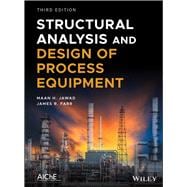Still the only book offering comprehensive coverage of the analysis and design of both API equipment and ASME pressure vessels
This edition of the classic guide to the analysis and design of process equipment has been thoroughly updated to reflect current practices as well as the latest ASME Codes and API standards. In addition to covering the code requirements governing the design of process equipment, the book supplies structural, mechanical, and chemical engineers with expert guidance to the analysis and design of storage tanks, pressure vessels, boilers, heat exchangers, and related process equipment and its associated external and internal components.
The use of process equipment, such as storage tanks, pressure vessels, and heat exchangers has expanded considerably over the last few decades in both the petroleum and chemical industries. The extremely high pressures and temperatures involved with the processes for which the equipment is designed makes it potentially very dangerous to property and life if the equipment is not designed and manufactured to an exacting standard. Accordingly, codes and standards such as the ASME and API were written to assure safety. Still the only guide covering the design of both API equipment and ASME pressure vessels, Structural Analysis and Design of Process Equipment, 3rd Edition:
- Covers the design of rectangular vessels with various side thicknesses and updated equations for the design of heat exchangers
- Now includes numerical vibration analysis needed for earthquake evaluation
- Relates the requirements of the ASME codes to international standards
- Describes, in detail, the background and assumptions made in deriving many design equations underpinning the ASME and API standards
- Includes methods for designing components that are not covered in either the API or ASME, including ring girders, leg supports, and internal components
- Contains procedures for calculating thermal stresses and discontinuity analysis of various components
Structural Analysis and Design of Process Equipment, 3rd Edition is an indispensable tool-of-the-trade for mechanical engineers and chemical engineers working in the petroleum and chemical industries, manufacturing, as well as plant engineers in need of a reference for process equipment in power plants, petrochemical facilities, and nuclear facilities.









